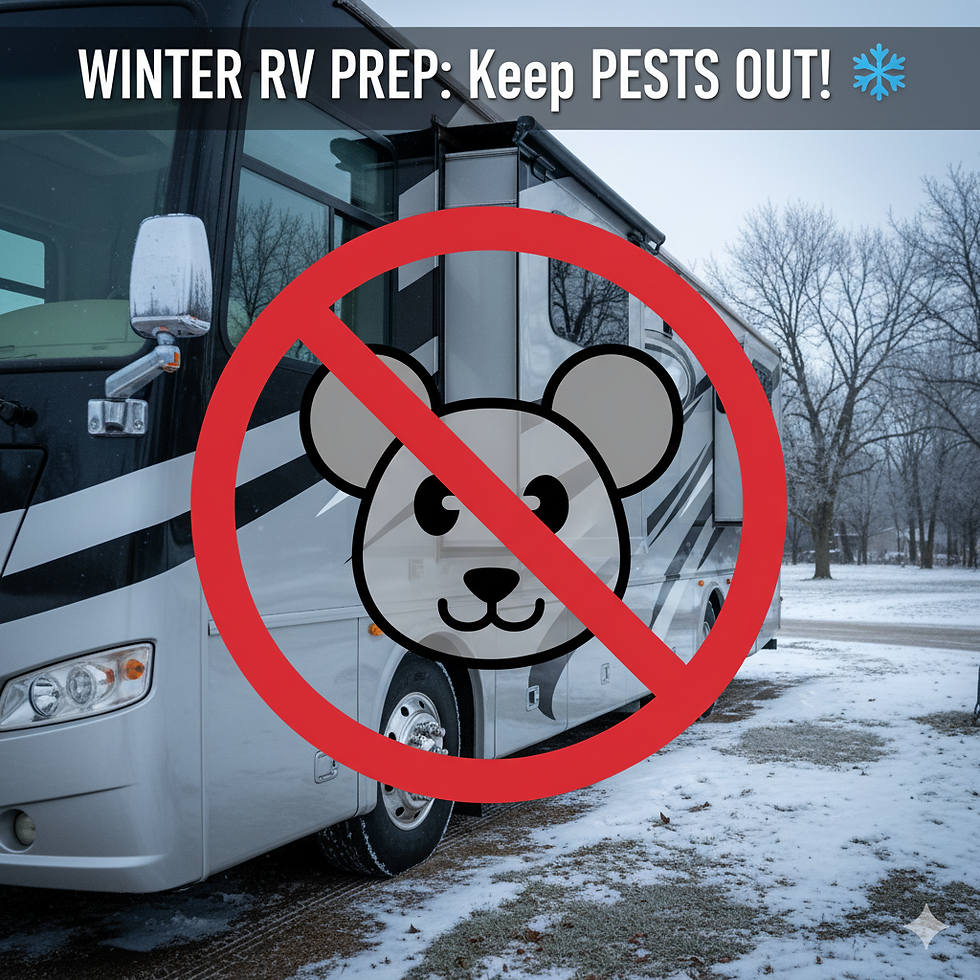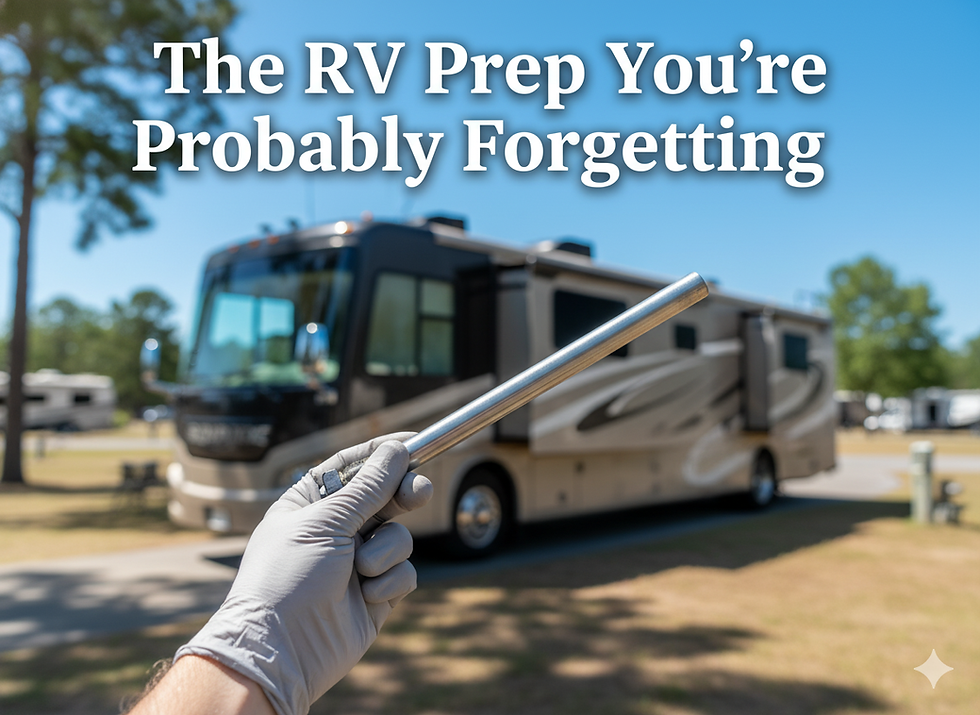The Dangers of RV Slide Stabilizers: Why Proper Maintenance Matters
- Nicholas Spence
- Jul 7
- 5 min read
Updated: Oct 21

The RV lifestyle offers unparalleled freedom and the ability to explore. However, the desire for a perfectly stable living space can lead some RV owners down a path that may harm their beloved recreational vehicle: the use of RV slide stabilizers. While these accessories are marketed to reduce movement, they can inflict significant long-term damage. This can lead to costly repairs and compromise the very integrity of your RV's slide-out system. In this blog, I will delve into the various ways RV slide stabilizers can be detrimental. I will highlight the dangers of their use and emphasize why proper slide maintenance is the true key to a healthy RV.
Understanding the Appeal of Stability
The allure of a rock-solid RV is understandable. Even with the leveling jacks down, slide-outs can still exhibit some movement. This is especially true when people walk through them or when wind gusts hit the side of the rig. This subtle wobble can be annoying, leading some RV owners to seek aftermarket slide stabilizers. These devices typically consist of adjustable poles that extend from the ground to the underside of the slide-out, ostensibly providing additional support.
However, the fundamental flaw in this approach lies in the design and intended function of RV slide-out systems. RV slide-outs are engineered to be dynamic. They are designed to extend and retract, with various components—motors, gears, tracks, and seals—meant to accommodate a degree of movement and flexibility. Introducing rigid, external stabilizers disrupts this delicate balance. This forced rigidity is the root cause of many problems associated with these devices.
The Risks of Using RV Slide Stabilizers
One of the most significant dangers of using RV slide stabilizers is the potential for crowning on the slide arms. Slide arms, whether mechanical rails or structural members, are designed to bear weight and operate within specific tolerances. When you introduce a stabilizer that pushes up on the underside of the slide-out, you create an upward force that is not evenly distributed. This concentrated upward pressure can cause the slide arms to bend or bow upwards in the middle, creating a "crown."
Imagine trying to support a long beam by pushing up in the center rather than supporting it evenly along its length. Over time, that concentrated upward pressure will deform the beam. The same principle applies to RV slide arms. This crowning effect may not be immediately apparent, but it's cumulative damage. Once the arms are crowned, the slide-out will no longer move smoothly or evenly. You might notice increased friction, groaning noises during operation, or even the slide-out getting stuck. Repairing crowned slide arms is not a simple fix; it often requires significant disassembly of the slide system and potentially costly component replacement—all because of an accessory meant to improve stability.
The Impact on Seals and Water Damage
Beyond structural damage to the slide arms, the use of stabilizers poses a grave threat to the seals that protect your RV from the elements. Slide-out seals are critical components, forming a watertight and airtight barrier between the slide-out and the main body of the RV when the slide is extended. These seals are designed to compress and decompress as the slide-out moves, maintaining a tight fit. When you use a stabilizer, you effectively "freeze" the slide-out in a rigid position. This constant, unyielding pressure can lead to premature wear and tear on the seals.
Consider what happens when your RV experiences even slight movements, such as those caused by occupants walking inside, wind, or minor ground settling. Without stabilizers, the slide-out and its seals are designed to flex and accommodate these movements. With stabilizers in place, however, the seals are subjected to constant friction and grinding against the RV's sidewall or the slide-out itself. This abrasive action can quickly abrade, tear, or deform the seals, compromising their ability to keep out water, dust, and pests.
A compromised seal is an open invitation to water damage, which is every RV owner's nightmare. Even a small leak can lead to extensive damage to the RV's interior, including rot in the wall structure, mold growth, and damage to electrical components. The cost of repairing water damage can far exceed any perceived benefit of using slide stabilizers. Furthermore, damaged seals mean increased energy loss, as your heating and air conditioning efforts will be less effective, leading to higher utility bills or discomfort.
The Myth of Wobble Reduction
Proponents of slide stabilizers often argue that they reduce the feeling of "wobble" inside the RV. However, this wobble is often a natural characteristic of a recreational vehicle on leveling jacks. RV frames are not rigid foundations; they are designed to flex and move. Attempting to eliminate all movement can actually be counterproductive, as it forces the entire structure to bear stresses in ways it wasn't intended. The subtle movement you feel is often the RV doing what it's designed to do: accommodate shifts in weight and external forces.
Instead of resorting to potentially damaging aftermarket products, the true solution to slide-out longevity and optimal performance lies in proper slide maintenance. This fundamental principle is often overlooked in the quest for perceived "stability." Regular, preventative maintenance goes a long way in ensuring your slide-outs operate smoothly and remain trouble-free for years to come.
Key Steps for Proper Slide Maintenance
Proper slide maintenance involves several key steps:
Regularly inspect your slide-out seals. Look for any signs of cracking, tearing, or deformation. Clean the seals with an RV-safe cleaner and apply a UV-protective conditioner designed for RV seals. This keeps them pliable and prevents them from sticking, reducing friction during operation.
Keep the slide-out tracks and gears clean and lubricated. Dirt, debris, and old lubricant can build up on these components, leading to increased friction and strain on the motor. Use a brush to remove loose debris, and then apply a dry silicone lubricant specifically designed for RV slide mechanisms. Avoid using grease or oil, as these can attract dirt and grime.
Monitor the operation of your slide-out. Listen for any unusual noises, such as grinding, squealing, or clunking. Observe how smoothly the slide-out extends and retracts. Any deviation from normal operation could indicate an underlying issue that needs to be addressed promptly. Catching problems early can prevent them from escalating into major repairs.
Ensure your RV is properly leveled before extending your slide-outs. While stabilizers attempt to compensate for perceived movement, a properly leveled RV on stable ground provides the best foundation for your slide-outs to operate as intended. This minimizes undue stress on the entire slide-out system.
Conclusion: Embrace Natural Flexibility
In conclusion, while the desire for a perfectly stable RV is understandable, the use of RV slide stabilizers is a misguided endeavor that can lead to significant and costly damage. From the insidious crowning of slide arms to the premature destruction of vital seals and increased strain on mechanical components, these devices disrupt the carefully engineered dynamics of your RV's slide-out system. Instead of investing in accessories that actively harm your RV, focus on the proactive and beneficial practice of proper slide maintenance.
Regular inspection, cleaning, lubrication, and mindful operation are the true pillars of slide-out longevity. This ensures your RV remains a reliable and comfortable home on wheels without succumbing to the avoidable pitfalls of external stabilizers. Embrace the natural flex of your RV, trust in its design, and prioritize maintenance over misguided attempts at artificial stability. Your RV will thank you for it with years of trouble-free enjoyment.
For more information on RV maintenance, check out RV Surgeons.




Comments